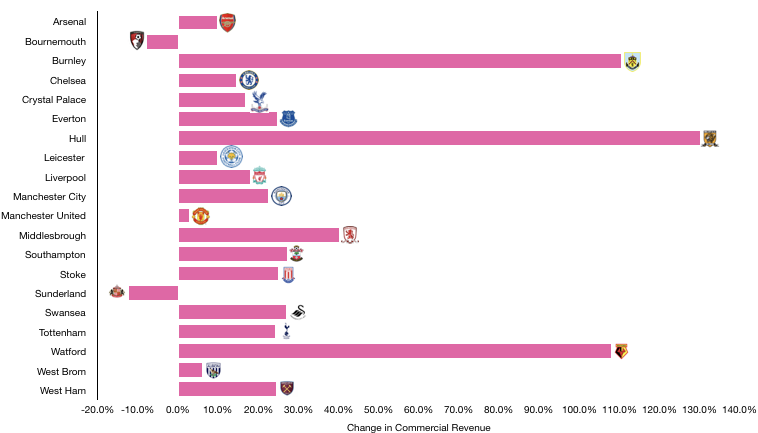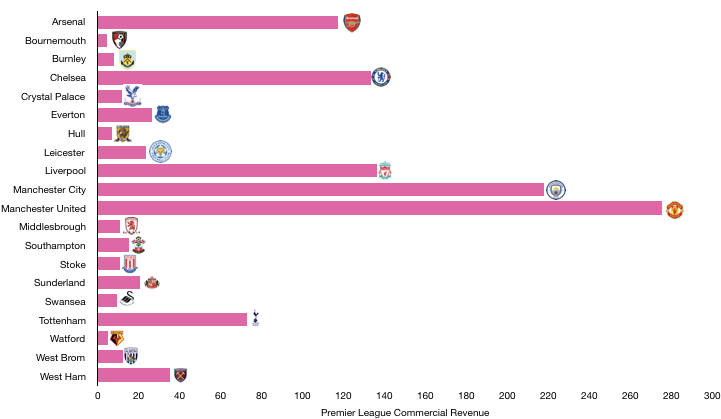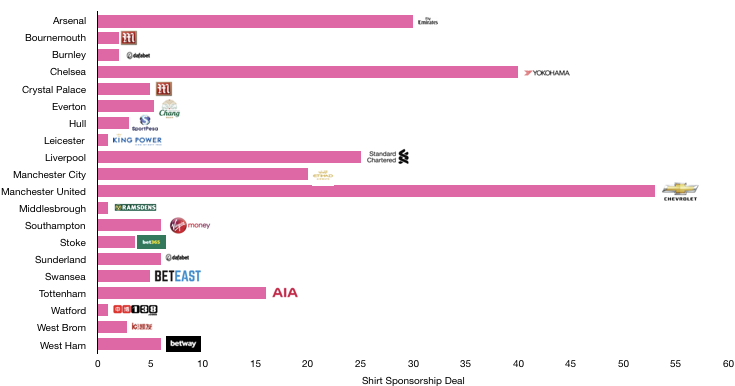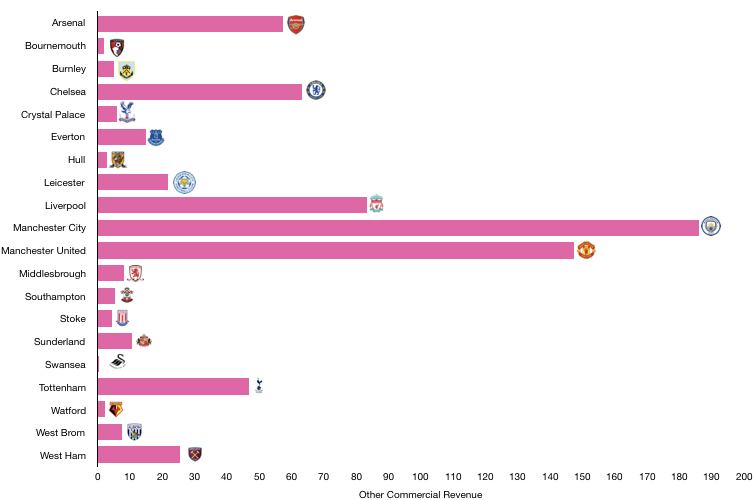As we have seen in the last article on Broadcasting Revenue, the majority of Premier League clubs rely on broadcasting revenue to make a profit. However, more and more so, to be competitive, Premier League sides have to up their commercial game in order to earn more revenue through commercial means.
Commercial revenue includes sponsorships, merchandise sales and social media revenue. Clubs are finding increasingly inventive ways to be sponsored. There is now everything from ‘official water providers’ to ‘official travel providers’ and there is also the recent introduction of sleeve sponsors, training ground sponsors as well as clubs (and fans) beginning to look more favourably on stadium naming right deals.
The growing importance of commercial revenue is showcased by the fact that £1,156m of revenue was through commercial means, 17.6% of total revenue, with this figure only going to increase as more and more riches enter the Premier League.
This article analyses the commercial revenue of all Premier League clubs in the 2016/17 season.
Let’s delve into the numbers.
Who’s Up, Who’s Down?

The majority of Premier League clubs experienced growth in commercial revenue as ever-increasing cash flows into the beautiful game. Of those, newly promoted Burnley and Hull saw the added financial benefit of promotion outside of Premier League TV money as their commercial revenue more than doubled. Middlesbrough, whose commercial revenue was already much larger than the other two, saw a more modest rise in commercial revenue. Watford, promoted in 2015, saw commercial revenue more than double also.
Manchester United are beginning to watch over their shoulder as their slowing growth (partly a function of having such large revenue), is seeing their rivals catch up with Arsenal, Chelsea, Liverpool, Manchester City and Tottenham all tripling Manchester United’s growth figure.
Elsewhere it was a good year for Everton, Southampton, Stoke, Swansea and West Ham who all achieved commercial growth of over 20%. This is in part due to negotiating new lucrative sponsorship deals after they all successfully retained their Premier League status the previous season.
On the other end of the scale is was a bad year for Bournemouth and Sunderland who both saw commercial revenue fall despite the influx of cash and ever-growing popularity of football. Bournemouth will in particular be disappointed due to their exciting brand of football, however their smaller fan base may attribute to their inability to obtain better commercial deals. Sunderland saw commercial revenue drop and will expect this to continue after relegation.
Commercially Sound?

Manchester United clearly lead the way in commercial revenue which will come as no surprise to anyone due to their global status as one of the three biggest clubs in the world alongside Barcelona and Real Madrid.
Manchester United’s huge sponsorship deals are well protected by long, lucrative contracts and will see them lead the way for some time.
Manchester City continue to make ground however and have grown their commercial revenue significantly in recent years with no sign of this letting up as the club continue to use a successful commercial strategy to make waves in the Premier League.
The other three from the traditional top 4 lag the Manchester clubs in commercial revenue and will be hoping to make headway in closing this gap with more lucrative sponsorship deals in the pipeline. The most worried club will be Tottenham who already lack the financial power of their rivals and continue to lag the others in revenue despite having successful seasons of late.
On the other side of the spectrum, both Watford and Bournemouth prop up the commercial table as their smaller fan bases fail to attract sponsors or large merchandise sales and as such need more inventive strategies to boost commercial revenue.
The Wearside clubs Sunderland and Middlesbrough owe their huge fan bases the majority of their commercial revenue. Their large reach up North has led to some lucrative sponsorship deals, deals that both will struggle to keep after costly relegations.
Despite their incredible title winning season, Leicester have failed to monetize commercially their success as their commercial revenue is still below Everton and West Ham due to already being in some sponsorship deals that had many years to run meaning they could not cancel without incurring large fees.
Kitted Out

Premier League clubs have two main sponsorship contracts, Kit manufacturer deals and shirt sponsorship deals. Kit manufacturers such as Nike and Adidas pay clubs for the right to produce shirts for them, taking a large cut of all sales thereafter. Shirt sponsors pay for the right to appear front and centre of a club’s shirts in the hope of attracting customers to their business.
We first look at kit deals and it is clear from the image above the imbalance between Premier League clubs and the amount of cash they receive for allowing these sport brands to produce their kits. Note, in some cases the amounts are lower for smaller clubs however they may retain a larger cut of any shirt sales.
Manchester United lead the way considerably, pulling in more than double any other Premier League club’s deals from their £75m a year deal with Adidas. This deal accounts for over a third of all kit deal income! This is a major reason for their financial clout, their ability to turn their global status into cash is unprecedented in the Premier League.
Following them is Arsenal, Chelsea and Liverpool some way behind, however all three are due for renewals shortly and will expect to be much more aligned with the Manchester United deal. Chelsea have already severed ties early with Adidas to join rivals Nike in a £60m a year deal and the likes of the above, as well as Tottenham and Manchester City will all expect to be in and around the £40-50m mark in the next two years.
Manchester City lag well behind as they patiently see out their deal with Nike as they look to switch to a new supplier, rumoured to be Puma.
Tottenham are also in a similar boat with Under Armour and will continue to look to catch up with their more illustrious rivals.
West Ham and Everton are the best of the rest, with Leicester unable to sever ties with their £1m a year puma deal which has restrained their financial growth (new Adidas is incoming) since their sensational Premier League success.
Kit deals for the lower end Premier League clubs is low, with many only gaining £1-2m per year from their kit manufacturer, however they may take home a larger percentage of shirt sales so those with a larger fan base, such as Middlesbrough and Leicester are likely to benefit more so from merchandise sales.
Let’s Get Shirty

On to shirt sponsors now and yet again this area is dominated by Manchester United with their £53m a year deal with Chevrolet leading the way.
The gap is smaller to the other big guns this time however, with Chelsea and Arsenal not too far behind them in terms of deal size. Chelsea and United lead the way in part due to having renegotiated deals recently and hence will see the gap fall when Liverpool and Tottenham in particular find new, more lucrative deals. It remains to be seen whether Arsenal and Manchester City, whose deals are intertwined with their owner’s relationship with the companies, will seek new more lucrative deals or increase the amount of their current ones (more on this below).
The best of the rest is once again West Ham and Everton, however many other Premier League clubs have just as strong sponsorship deals as the likes of Crystal Place and Southampton look to be more aggressive in the commercial market and source better deals.
Watford and Middlesbrough failed to do this last year and lag the rest, with Middlesbrough paying a heavy price as their relegation will mean they will be unable to remedy this shortfall.
Show Me The (Other) Money!

We have talked about the main two types of commercial income, shirt sponsors and kit deals, however there is an increasing variety in commercial income as clubs sell more merchandise and other sponsorship deals (Stadiums, Sleeves, official partners etc.).
Leading the way here is surprisingly Manchester City, beating out competition from their Manchester rivals. Manchester City lead in other income after already having sold their stadium naming rights to Etihad Airways, while their clutch of smaller deals has seen them edge out Manchester United as they look to find new ways to compete financial with their rivals.
Liverpool, Chelsea and Arsenal all have significant income from merchandise and other sponsorship deals, with this likely to continue to increase as they all look for official partners in any industry you can think of.
Tottenham lag behind again, followed by Leicester and West Ham as Leicester’s title winning campaign unsurprisingly boosted commercial revenue.
On the other end of the scale, Swansea, Watford, Bournemouth and Hull have failed to sail much outside their main deals and will hope to improve on this in the future.
Current Developments (For current Premier League teams analysed)
As with anything in football, things move quickly, and clubs are always looking to bridge the financial gap between themselves and their rivals.
Below is a brief breakdown of the major commercial changes of all Premier League clubs that remain in the Premier League for the upcoming season.
Arsenal have looked to do this with an extension on improved terms of around £40m a year on their Fly Emirates deal while they have also netted the most lucrative sleeve deal to date of around £10m a year with Visit Rwanda.
Bournemouth after a disappointing commercial year have signed a record-breaking deal with M88 while also securing previous sponsor Mansion as their first sleeve sponsor.
Burnley have gained a record-breaking sponsorship deal with LaBa360 and a sleeve deal with Golf Cash.
Chelsea have netted a huge £60m deal with Nike after cutting short their less lucrative adidas deal and they have also signed Alliance Tyres as their sleeve sponsor.
Crystal Palace have signed a record-breaking deal with ManBetX and sleeve deal with Dongqiudi.
Everton signed a record-breaking deal with SportPesa and an unusual sleeve deal with Angry Birds.
Leicester have signed a new kit deal with Adidas after abandoning Puma whilst they have also signed Siam Bank as their sleeve sponsor.
Liverpool have renegotiated their Standard Chartered deal to around £40m whilst agreeing a sleeve deal with Western Union.
Manchester City are rumoured to be closing in on a Puma kit deal of around £50m a year and have signed Nexen Tyres as their sleeve sponsor. Manchester City have also signed a lucrative documentary deal with Amazon.
Manchester United had a quiet year, recently signing Kohler as their sleeve sponsor.
Southampton added Virgin Media to their sleeve, having already had them as their main shirt sponsor.
Tottenham have made waves in trying to catch their rivals, signing a more lucrative contract with main shirt sponsor AIA, Tottenhamare yet to sign a sleeve sponsor.
Watford signed 138.com, once a main shirt sponsor, as their new sleeve sponsor.
West Ham signed Basset & Gold as their first sleeve sponsor.
Thanks for reading. Share with your friends!

